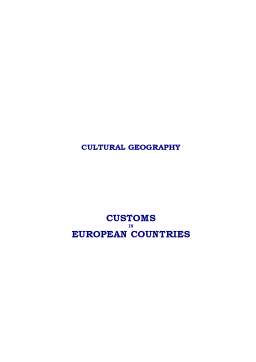Cuprins
- AUSTRIA 4
- BELGIUM 6
- BULGARIA 8
- CROATIA 10
- DENMARK 12
- ENGLAND 14
- ESTONIA 16
- FINLAND 18
- FRANCE 20
- GERMANY 22
- GREECE 25
- HUNGARY 27
- ICELAND 29
- IRELAND 31
- ITALY 33
- LIECHTENSTEIN 35
- LITHUANIA 37
- LUXEMBOURG 39
- MOLDOVA 41
- NETHERLANDS 43
- NORWAY 45
- POLAND 46
- PORTUGAL 48
- ROMANIA 50
- RUSSIA 52
- SCOTLAND 54
- SLOVAKIA 56
- SPAIN 58
- SWEDEN 60
- SWITZERLAND 62
- TURKEY 64
- UKRAINE 66
- WALES 68
Extras din proiect
AUSTRIA
Marriage and Family
Couples often decide to live together before or instead of marriage. Many people
marry in church, but a civil ceremony must also be performed for a marriage to be legal.
In urban areas, families tend to be small, but rural families are often a bit larger.
Both parents generally work outside the home, so couples tend to share duties related to
the household and children. The government gives families financial allowances for each
child. Children who are not in school and whose parents both work are cared for
privately or in day-care centers. Most urban Austrians live in apartments, whereas in
rural areas people more often live in single-family houses. About one-fifth of all housing
is publicly owned.
Eating
Austrian cuisine is drawn from the various cultures that once composed the
Austro-Hungarian Empire. Specialties vary by region, but include traditional dishes
such as Wiener Schnitzel (breaded veal cutlet), Knödel (moist potato dumplings), and
goulash. Pastries and cakes, such as Sachertorte (a rich chocolate cake with apricot jam
and chocolate icing), are also extremely popular. Beer and wine are both produced in
Austria.
A typical day begins with a light breakfast of coffee or hot chocolate, rolls, bread,
and jam or marmalade. There are numerous sausage stands in cities, and shoppers may
buy sausages to eat as a snack between meals, often in the late morning. Traditionally
the main meal is in the middle of the day, but for families in which both parents work
outside the home, the evening meal is often the main one. Families try to eat at least one
meal together each day. Whether at midday or in the evening, the main meal may
include soup, meat with potatoes or pasta, vegetables, a salad, and often dessert (such
as a homemade pastry). Austrians eat a wide variety of meat, including Rindfleisch
(beef), Schweinefleisch (pork), Huhn (chicken), Wurst (sausage), Kalbfleisch (veal), and
Wild (venison).
Jause (afternoon tea), which is less common today, might include sandwiches,
pastries, and coffee. If the main meal is eaten at midday, families have Nachtmahl
(supper) in the evening. This generally includes cold cuts of meat, eggs, cheese, rye or
another type of bread, and a salad. Goulash or hot sausages may be eaten at the midday
or evening meal.
Austrians, like other Europeans, eat with the fork in their left hand and knife in
their right, both when cutting food and eating. Guests will almost always be offered
second helpings, but no offense will be caused by declining with a polite Danke, nein
(“Thank you, no”).
Socializing
A handshake is usual on greeting, coupled with any of a number of phrases such
as Guten Morgen (“Good morning”), Guten Tag (“Good day”), Guten Abend (“Good
evening”), or Grüß Gott! (“May God greet you!”). Popular casual greetings include Servus!
(“Hi!”) and Grüß Dich! (“Greetings to you!”). Austrians do not ask Wie geht es Ihnen?
(“How are you?”) unless they wish to hear a detailed account.
Professional titles are important among the adult population and are used
whenever known. Otherwise, titles such as Herr (“Mr.”) and Frau (“Mrs.” or “Ms.”) are
combined with family names when addressing acquaintances and strangers. Close
friends and young people use first names. As a general rule, one does not use someone’s
first name unless invited to do so.
5
Austrians enjoy entertaining in the home, but unless one knows someone very
well it is considered impolite to drop by unannounced. It is important to be punctual,
and in some homes guests are expected to remove their shoes upon entering; guest
slippers are usually visible near the door. A Gasthaus, or bar, is a popular spot for
socializing outside the home. Friends may also get together at a Kaffeehaus (coffeehouse)
or park.
Recreation
Winter and summer are the most active sporting seasons in Austria, due to the
country's mountainous terrain. In the mountains, cross-country and downhill skiing,
snowboarding, and skating are popular winter sports. In summer, mountaineering,
hiking, and biking prevail in these areas. Water sports, such as swimming and boating,
are also popular summer sports. In cities, taking a walk (ein Spaziergang) is a wellestablished
tradition. Soccer is the most popular team sport.
Holidays and Celebrations
New Year’s Eve in Austria is also referred to as Sylvester’s Eve. By tradition,
Austrians melt a small piece of lead over a lit candle or other flame and quickly pour it
into cold water. The lead figure that is produced is seen as a symbol of the coming year.
People also exchange lucky charms, such as marzipan pigs, horseshoes, and chocolate
coins.
The Epiphany (6 January) shares the same date as a special day called the
Perchtenlauf. Fasching is the Austrian equivalent to Mardi Gras, Carnival, or Fastnacht.
Fasching, which immediately precedes Lent, offers opportunity for an indulgent
celebration before the fasting and solemnity associated with Lent.
Preview document
Conținut arhivă zip
- Customs in European Countries.pdf




















































































